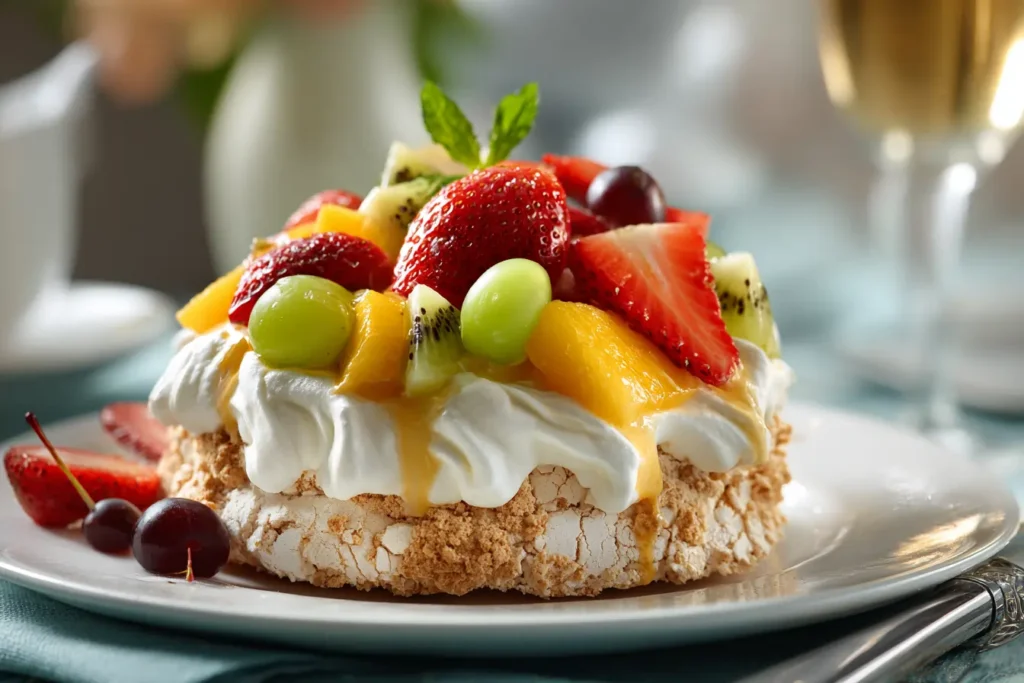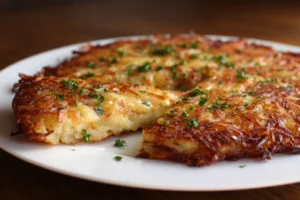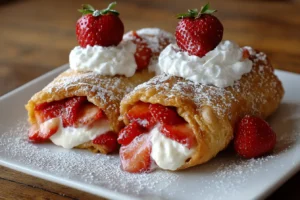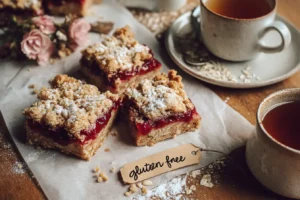Every family has a dessert that sparks nostalgia—a sweet memory woven into celebrations and everyday moments alike. For many in Monterrey, Mexico, that dessert is Mostachon Cake. My first taste came at a friend’s birthday party: a slice with a crispy meringue, sweet whipped cream, and a burst of fresh fruit. I didn’t know it then, but that bite would begin a long love affair with this iconic cake—a treat that brings people together across generations. Now, let’s discover why Mostachon Cake has become a beloved staple, and how you can bring its magic to your own table.
Introduction
Mexico is home to a dazzling variety of desserts, each with its own story, flavors, and cultural importance. Among these, the Mostachon Cake stands out for its irresistible combination of crunch, creaminess, and freshness. Unlike other cakes that rely on flour or butter for their base, mostachon is all about a nutty, airy meringue foundation, layered with whipped cream and topped with colorful, juicy fruit. If you’re a fan of nutty treats, you’ll also love our collection of pecan dessert recipes that showcase the versatility of this ingredient.
But what exactly is Mostachon Cake, and why has it become a favorite for special occasions in homes across Northern Mexico? Whether you’re an experienced baker searching for your next challenge or simply someone with a sweet tooth looking to try something new, Mostachon Cake offers a delightful blend of taste, texture, and history. Curious about more cakes that combine unique flavors and easy techniques? Don’t miss our guide to easy pecan cake desserts for more inspiration.
In this ultimate guide, you’ll discover everything you need to know about this iconic dessert—from its origins in Monterrey, to a step-by-step recipe, to creative variations you can try at home. You’ll also learn expert tips for making your mostachon stand out, how to store and serve it for maximum enjoyment, and answers to all your burning mostachon questions. And if you’re in the mood for more sweets from Latin America, be sure to explore more Latin American desserts and find your new favorites.
By the end of this article, you’ll not only be ready to bake your own Mostachon Cake, but you’ll also understand why it has captured the hearts (and taste buds) of dessert lovers everywhere. Get ready to experience a Mexican classic that’s crunchy, creamy, and completely unforgettable.
Table of Contents
Table of Contents
The Origin & History of Mostachon Cake
Every dessert has a story, and Mostachon Cake is no exception. Its roots are firmly planted in the vibrant city of Monterrey, in Northern Mexico—a region known for its rich culinary traditions and festive gatherings. The cake’s unique name, “mostachon,” is believed to be a playful nod to the word “mostacho,” or mustache, perhaps referring to the way the meringue rises and forms fluffy, mustache-like peaks during baking.
Mostachon Cake first became popular in Monterrey households in the mid-20th century, quickly becoming a staple at birthdays, family reunions, and holidays. Unlike many traditional cakes, mostachon relies on a base made of meringue, pecans, and crushed Maria cookies. This creates a delightfully crunchy and chewy texture that sets it apart from other desserts. Topped with a generous layer of whipped cream or cream cheese frosting and a crown of fresh fruit, the cake beautifully balances sweetness, texture, and vibrant colors.
As the years have passed, bakers have created a wide range of new twists on the original recipe. Some bakers add tropical fruits like mango or pineapple for a fresh twist, while others experiment with different nuts or chocolate. Despite these modern spins, the heart of Mostachon Cake remains the same: a celebration dessert designed to bring people together.
Interestingly, the rise of mostachon coincided with Mexico’s postwar economic boom, when imported ingredients like Maria cookies became more accessible. This helped the dessert spread beyond Monterrey and into other regions of Mexico and Latin America, where it is now enjoyed in both home kitchens and trendy bakeries.
Today, Mostachon Cake continues to evolve and inspire, often featured in food blogs and Mexican celebrations worldwide. If you’d like to explore how other Latin desserts have crossed borders and influenced global cuisine, you can explore more Latin American desserts for additional context and ideas.
What Makes Mostachon Cake Unique?
Mostachon Cake is unlike any typical dessert you’ll find on a bakery shelf. Its signature character comes from a base made not with flour or butter, but with a crunchy meringue composed of whipped egg whites, sugar, pecans, and crushed Maria cookies. This combination results in a chewy, slightly nutty texture that beautifully contrasts with the soft, creamy topping.
What truly sets mostachon apart is its delightful mix of textures in every bite. The meringue foundation delivers crunch and chewiness in every bite, while a lush layer of whipped cream (sometimes blended with cream cheese for a tangy note) adds a smooth, airy finish. Generous helpings of fresh fruit—commonly strawberries, kiwi, and grapes—bring color, brightness, and juicy freshness, making each slice a visual and flavorful delight.
Another unique aspect is its adaptability. Mostachon easily welcomes creative substitutions: pecans can be swapped for walnuts or almonds, and seasonal fruits can be added for different tastes throughout the year. This makes it a flexible choice for bakers wanting to put their own twist on a traditional recipe. If you’re inspired by cakes that blend diverse flavors and textures, you might also enjoy exploring other easy pecan cake desserts for more ideas.
Unlike more familiar meringue-based cakes such as Pavlova or Sans Rival, mostachon has a denser, heartier base thanks to the addition of cookies and nuts. The result is a cake that feels both rustic and celebratory, equally at home at a backyard cookout or a festive holiday table.
In short, what makes mostachon truly special is its mix of textures, flavors, and its ability to bring people together for a memorable, mouthwatering treat.
Essential Ingredients & Tools

Before you begin crafting your own Mostachon Cake, it’s helpful to gather all the essential ingredients and tools. Each component plays a key role in creating the cake’s unique taste and texture:
Key Ingredients
- Egg Whites: The foundation of the meringue, providing structure and lift.
- Sugar: Adds sweetness and helps stabilize the whipped egg whites.
- Pecans: Traditionally used for their buttery flavor and crunch; you can also try other nuts like walnuts for a twist. If you love nutty flavors, explore more pecan dessert recipes for inspiration.
- Maria Cookies: Crushed to form part of the base, adding subtle sweetness and texture. Graham crackers or digestive biscuits can be substituted if needed.
- Cream Cheese & Whipped Cream: These form the luscious topping. Some recipes use only whipped cream, while others blend it with cream cheese for extra richness.
- Fresh Fruit: Strawberries, kiwi, grapes, or tropical fruits like mango—these not only decorate the cake but also balance the sweetness and richness.
Recommended Tools
- Electric Mixer: Essential for beating egg whites to stiff peaks.
- Mixing Bowls: At least two, preferably glass or metal for whipping egg whites.
- Rubber Spatula: Ideal for carefully blending ingredients while keeping the meringue light and airy.
- Cake Pan or Springform Pan: To shape and support the meringue as it bakes.
With the right ingredients and equipment ready, you’re set to create a Mostachon Cake that’s both impressive and delicious!
Classic Mostachon Cake Recipe (Step-by-Step)
Print
Mostachon Cake
- Total Time: 1 hour
- Yield: 10–12 servings 1x
- Diet: Vegetarian
Description
A classic Mexican dessert from Monterrey, Mostachon Cake features a crunchy meringue base with pecans and Maria cookies, topped with a creamy layer and fresh fruit. It’s a showstopping treat perfect for celebrations and family gatherings.
Ingredients
For the Meringue Base:
-
6 large egg whites, at room temperature
-
1 cup granulated sugar
-
1 teaspoon vanilla extract
-
1 cup chopped pecans (or walnuts/almonds)
-
1 cup crushed Maria cookies (about 15 cookies)
For the Creamy Topping:
-
8 oz (225g) cream cheese, softened
-
1 cup heavy whipping cream
-
1/2 cup powdered sugar
-
1 teaspoon vanilla extract
For Decoration:
-
2 cups mixed fresh fruit (strawberries, kiwi, grapes, mango, etc.)
Instructions
- Preheat the Oven:
Preheat oven to 350°F (175°C). Line a 9-inch round cake pan or springform pan with parchment paper. - Make the Meringue Base:
In a clean, dry mixing bowl, beat egg whites on medium speed until soft peaks form. Gradually add granulated sugar, continuing to beat until stiff, glossy peaks form. Mix in vanilla. - Fold in Pecans & Cookies:
Gently fold in chopped pecans and crushed Maria cookies using a rubber spatula, being careful not to deflate the meringue. - Bake:
Pour mixture into the prepared pan and smooth the surface. Bake for 30–35 minutes, or until golden and set. Cool completely in the pan. - Prepare Creamy Topping:
In a separate bowl, beat the cream cheese until smooth. In another bowl, whip heavy cream with powdered sugar and vanilla until stiff peaks form. Gently fold whipped cream into the cream cheese until fully combined - Assemble Cake:
Remove the cooled meringue base from the pan and place on a serving plate. Spread the creamy topping evenly over the base. - Decorate:
Arrange fresh fruit on top just before serving.
Notes
-
Substitute pecans with walnuts or almonds if desired.
-
Gluten-free vanilla wafers can replace Maria cookies for a gluten-free option.
-
Add fruit right before serving to keep it looking fresh.
-
Best enjoyed the same day, but can be refrigerated for up to 3 days.
- Prep Time: 25 minutes
- Cook Time: 35 minutes
- Category: Dessert
- Method: Baking
- Cuisine: Mexican
Nutrition
- Serving Size: 1 slice (1/12 cake)
- Calories: 285
- Sugar: 21g
- Sodium: 85mg
- Fat: 15g
- Saturated Fat: 6g
- Unsaturated Fat: 7g
- Trans Fat: 0g
- Carbohydrates: 32g
- Fiber: 1g
- Protein: 4g
- Cholesterol: 35mg
Ready to bake your own Mostachon Cake? Follow this classic recipe to experience the magic of this Mexican favorite right in your kitchen. The combination of crunchy meringue, creamy topping, and fresh fruit creates a dessert that’s always a showstopper.
Ingredients
- For the Meringue Base:
- 6 large egg whites, at room temperature
- 1 cup granulated sugar
- 1 teaspoon vanilla extract
- 1 cup chopped pecans (or substitute walnuts/almonds)
- 1 cup crushed Maria cookies (about 15 cookies)
- For the Topping:
- 8 ounces cream cheese, softened
- 1 cup heavy whipping cream
- 1/2 cup powdered sugar
- 1 teaspoon vanilla extract
- For the Decoration:
- 2 cups mixed fresh fruit (strawberries, kiwi, grapes, mango, etc.)
Instructions
- Preheat the Oven:
Preheat your oven to 350°F (175°C). Line a round 9-inch cake pan or springform pan with parchment paper. - Make the Meringue:
Using a spotless, dry bowl, whisk the egg whites with an electric mixer on medium speed until they hold soft peaks. Gradually add the granulated sugar, one tablespoon at a time, beating until the mixture is glossy and forms stiff peaks. Beat in the vanilla extract. - Fold in the Crunch:
Gently fold in the chopped pecans and crushed Maria cookies using a rubber spatula. Be careful not to deflate the meringue. - Bake the Meringue Base:
Pour the batter into your lined pan and gently even out the surface. Bake for 30-35 minutes, or until the meringue is golden and set but still slightly soft inside. Cool completely in the pan. - Prepare the Creamy Topping:
In a separate bowl, whip the cream cheese until it becomes creamy and lump-free. Add the powdered sugar and vanilla, mixing well. In a separate bowl, whip the heavy cream until stiff peaks form, then gently fold it into the cream cheese mixture. - Assemble the Cake:
Remove the cooled meringue base from the pan and transfer to a serving plate. Spread the cream cheese and whipped cream topping over the meringue. - Decorate:
Arrange fresh fruit over the top as desired, creating colorful patterns or simply piling the fruit on generously.
Tips for Success
- Make sure your mixing bowl and beaters are clean and free of any grease when whipping egg whites.
- Don’t open the oven door during baking; sudden changes in temperature can cause the meringue to collapse.
- Use room-temperature ingredients for the best texture.
If you’re craving more inspiration for creative cakes with nuts, check out our easy pecan cake desserts for delicious variations!
Popular Variations & Modern Twists
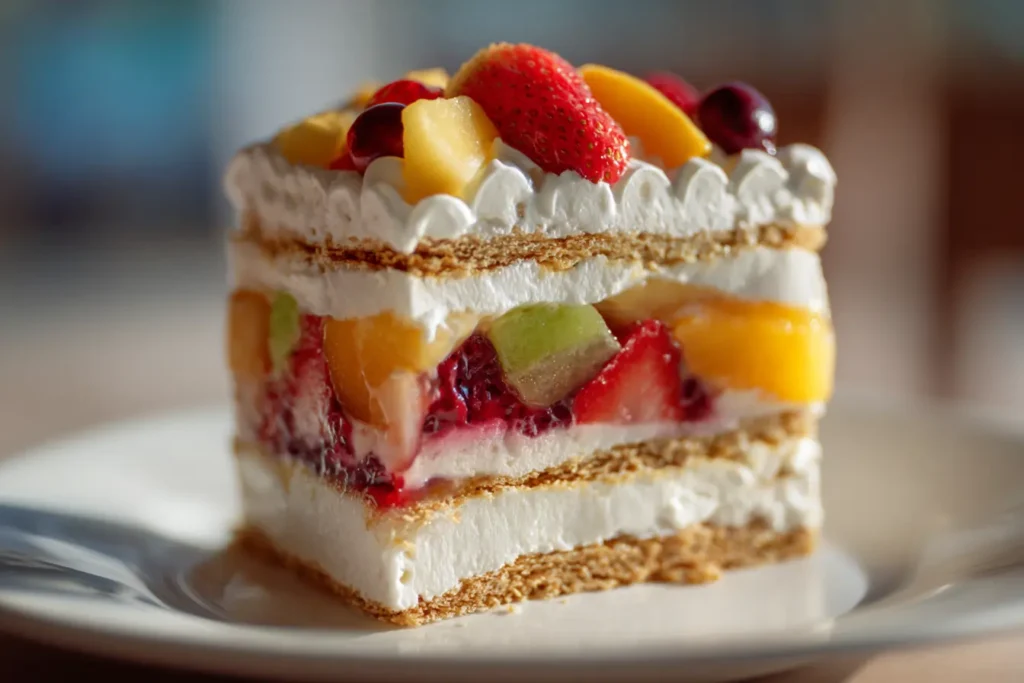
One of the reasons Mostachon Cake remains beloved is its remarkable versatility. Home bakers and chefs alike have put their creative spins on the classic recipe, adapting it to suit dietary needs, available ingredients, or simply to try something new.
Gluten-Free Mostachon
To make this dessert gluten-free, simply substitute the traditional Maria cookies with gluten-free vanilla wafers or gluten-free graham crackers. The cake’s texture and flavor remain just as delightful, but it becomes accessible to those with gluten sensitivities.
Nut-Free or Allergy-Friendly
Pecans are a signature ingredient, but you can swap them out for sunflower seeds or pumpkin seeds to create a nut-free version. This variation is perfect for those with nut allergies, and it still provides the signature crunch that defines mostachon.
Vegan Mostachon
For a vegan twist, use aquafaba (chickpea brine) instead of egg whites for the meringue, and replace the cream cheese and whipped cream with coconut cream or plant-based alternatives. The taste and texture come remarkably close to the classic version.
Chocolate Mostachon
Add cocoa powder to the meringue base or sprinkle chocolate chips before baking for a chocolaty upgrade. A touch of melted chocolate over the top goes perfectly with a handful of fresh berries.
Tropical Fruit Mostachon
Though strawberries, kiwi, and grapes are the traditional choices, feel free to top your cake with mango, pineapple, or passion fruit for a colorful, tropical flair.
Mini Mostachon Cakes
Make individual servings by dividing the meringue mixture into muffin tins or small ramekins—perfect for parties and easy portion control!
For more Mexican-inspired dessert ideas, check out our guide to Mexican-inspired desserts that celebrate bold flavors and creativity.
Serving, Storing, and Make-Ahead Tips
The joy of Mostachon Cake is not only in making it, but also in serving it at its very best. Here’s how to get the most out of every slice:
Serving Suggestions
Mostachon tastes best when served cold, giving time for the creamy layer and meringue to blend their flavors perfectly. For a showstopping presentation, arrange your favorite fresh fruit just before serving to keep it looking vibrant. Use a sharp knife dipped in hot water for cleaner slices, especially if the meringue is extra chewy.
This cake is ideal for birthdays, holidays, and gatherings, but it’s just as welcome at a casual brunch or family dinner. Pair a slice with a cup of coffee or a glass of dessert wine to elevate the experience.
Storing Mostachon Cake
Store leftover mostachon in the refrigerator, loosely covered with plastic wrap or in an airtight container. It will stay fresh for up to 3 days, though the meringue may soften slightly as it absorbs moisture from the cream and fruit.
Make-Ahead Tips
Mostachon Cake can be prepared a day ahead! Bake the meringue base and keep it covered at room temperature. Assemble with cream and fruit a few hours before serving for best results. Avoid freezing, as the meringue’s texture doesn’t hold up well after thawing.
For more clever ways to store or prep desserts in advance, see our tips in the easy pecan cake desserts guide.
Mostachon Cake Presentation & Decoration Ideas
A Mostachon Cake isn’t just delicious—it’s a feast for the eyes! Presentation plays a big role in making this dessert the centerpiece of any celebration. Whether you prefer a rustic look or want to create a modern showstopper, here are some ideas to inspire your creativity:
Classic Rustic Style
Embrace the cake’s natural charm by spreading the cream topping in soft, swirling patterns. Layer sliced strawberries, kiwi, grapes, and berries in casual clusters. Sprinkle a few extra chopped pecans or even edible flower petals for a touch of whimsy.
Modern, Decorated Styles
For special occasions, arrange fruit slices in concentric circles or decorative patterns for a more polished appearance. Fan out thinly sliced kiwi or strawberries for a floral effect. Try piping the cream topping using a pastry bag with a star tip for added texture and elegance.
Colorful Combinations
Use a vibrant mix of fruits—think mango, blueberries, raspberries, and pineapple—for a tropical twist. Add a handful of mint leaves or candied citrus peel to brighten the cake visually and flavor-wise.
Finishing Touches
Dust with powdered sugar for a snowy effect or drizzle with a little chocolate or fruit coulis. Lightly toast some coconut flakes or pecan pieces for extra crunch.
No matter which style you choose, your Mostachon Cake will stand out as a gorgeous centerpiece. For more inspiration on creative baking presentations, don’t miss our tips in the pecan dessert recipes collection.
Pairings & Serving Suggestions
Mostachon Cake is a festive dessert, and pairing it with the right drinks and side dishes can make your occasion even more memorable. Its combination of crunchy, creamy, and fruity flavors pairs well with both classic and unexpected accompaniments.
Drinks to Pair With Mostachon Cake
- Coffee: A rich, freshly brewed coffee or espresso balances the cake’s sweetness and highlights the nutty undertones of the meringue.
- Tea: Fruity herbal teas or floral blends such as chamomile make for a light, refreshing pairing.
- Dessert Wine: A sweet or semi-sweet dessert wine, like Moscato or a light sparkling wine, elevates Mostachon’s fruity elements.
Dishes to Serve Alongside
Mostachon Cake is often enjoyed as the grand finale to a celebratory meal. Serve it after a Mexican-inspired dinner, or pair it with lighter fare such as fruit salads or simple custards for contrast.
When to Serve Mostachon
Mostachon is a showstopper at birthdays, holidays, and weddings, but it’s equally delightful for Sunday brunch or as a treat at family gatherings. If you’re exploring other festive Latin desserts to serve at your next party, check out our Mexican-inspired desserts for more ideas.
With the right pairings, Mostachon Cake becomes not just a dessert, but a true celebration!
Troubleshooting Common Mostachon Cake Problems
Even seasoned bakers can run into a few bumps when making Mostachon Cake. Don’t worry—most issues are easy to fix with a few simple tips!
Meringue Doesn’t Rise or Collapses
- Possible Cause: Egg whites may have traces of yolk, the bowl wasn’t completely clean, or sugar was added too quickly.
- Solution: Always use clean, dry equipment and separate egg whites carefully. Add sugar gradually, and beat until you get glossy, stiff peaks.
- Extra Help: For perfect results, check out our tips in the pecan dessert recipes section.
Soggy or Weeping Meringue
- Possible Cause: Overbeating the egg whites, baking at too low a temperature, or high humidity.
- Solution: Beat egg whites just until stiff peaks form. Bake on a dry, less humid day if possible, and avoid overbaking.
Cake Cracks or Falls Apart
- Possible Cause: The meringue may be overcooked, or cooled too quickly.
- Solution: Bake until just set and golden, and let the cake cool gradually in the oven with the door slightly open to prevent cracks.
Whipped Cream or Topping Is Runny
- Possible Cause: Cream was not cold enough or under-whipped.
- Solution: Use well-chilled heavy cream and beat until stiff peaks form before folding into cream cheese.
Fruit Makes Cake Watery
- Possible Cause: Juicy fruits were added too far in advance.
- Solution: Add fruit just before serving and gently pat fruit dry with paper towels to minimize moisture.
Remember, even if your Mostachon isn’t picture-perfect, it will still taste amazing. With a bit of practice and patience, you’ll master this celebratory dessert in no time!
Health, Allergies, & Dietary Modifications
Mostachon Cake can be made to suit a wide range of dietary needs and preferences—making it a versatile treat for any gathering. Here are some simple swaps and tips to accommodate your guests:
Nut-Free Alternatives
If someone in your group has a nut allergy, you can replace the traditional pecans with roasted sunflower seeds or pumpkin seeds. These alternatives keep the cake’s signature crunch and flavor while making it safe for everyone to enjoy.
Dairy-Free and Vegan Options
For a dairy-free version, use plant-based cream cheese and coconut whipped cream in place of the dairy toppings. Aquafaba (the liquid from canned chickpeas) can be whipped to make an egg-free meringue for a vegan Mostachon—try it with your favorite egg replacer for best results.
Reducing Sugar
To cut down on sugar, opt for a sugar substitute suitable for baking (such as erythritol or monk fruit sweetener) in both the meringue and the cream topping. Use naturally sweet fruits like mango or ripe berries to enhance the cake’s flavor without extra sugar.
Calorie Information
Mostachon Cake is a lighter option compared to butter-rich cakes, but it’s still a dessert! Depending on your choice of ingredients and toppings, each slice usually contains between 250 and 350 calories.
For more guidance on creative and inclusive desserts, explore our roundup of easy pecan cake desserts for further ideas.
Mostachon Cake in Popular Culture & Media
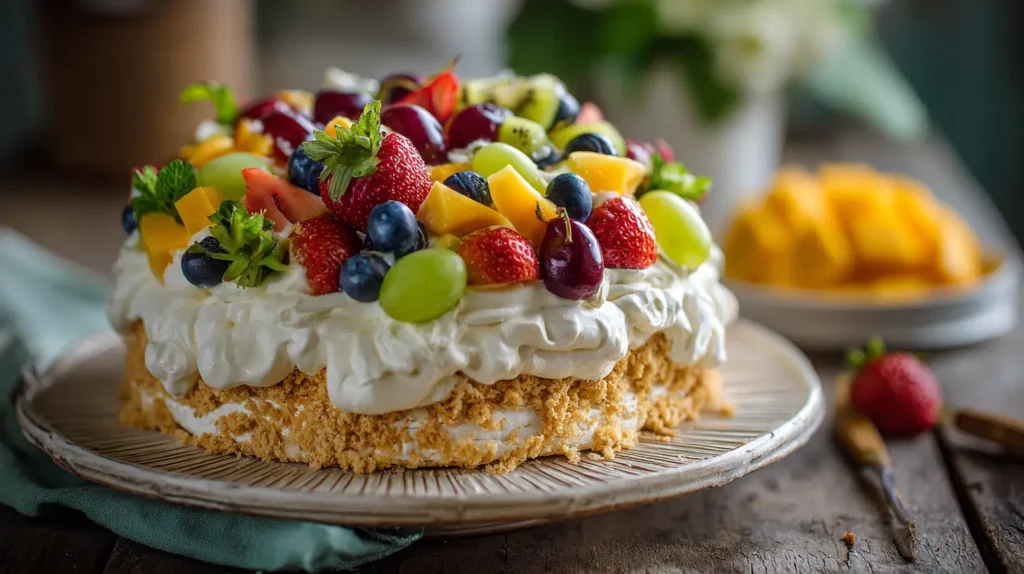
Mostachon Cake may have originated in Monterrey kitchens, but its fame has spread far beyond Northern Mexico. Today, it frequently appears in food blogs, cooking shows, and viral social media posts—especially during festive seasons and family celebrations. Its visually striking layers of crunchy meringue, fluffy cream, and jewel-like fruit make it a popular dessert for sharing online, inspiring countless bakers to try their own versions.
Food influencers and recipe developers often showcase Mostachon’s versatility by experimenting with unique toppings or modern twists, keeping the dessert fresh and trendy. In Mexican and Latin American food culture, the cake is now recognized as a symbol of creativity and togetherness at the dessert table.
If you want to discover other Mexican-inspired desserts that have made their mark online and in popular media, don’t miss our collection of Mexican-inspired desserts for more tasty inspiration.
Mostachon Cake Around the World: Regional Variations
While Mostachon Cake is rooted in the culinary traditions of Monterrey, its popularity has inspired bakers across Mexico and beyond to create their own unique twists. In Northern Mexico, the classic version—with pecans, Maria cookies, and a crown of tropical fruit—remains the gold standard for celebrations. However, as the cake has traveled to other regions, it has taken on new flavors and forms.
In Central and Southern Mexico, you might find Mostachon made with locally available nuts such as walnuts or almonds, or topped with regional fruits like guava, pineapple, or even prickly pear. Some bakers in the U.S. and Latin American communities experiment with additions like cocoa, dulce de leche, or even espresso for a fusion dessert.
Internationally, Mostachon is often compared to meringue cakes like Pavlova or Sans Rival, but its distinctive cookie-and-nut meringue base sets it apart. Interested in more cross-cultural dessert inspiration? Don’t miss the chance to discover other Latin American desserts for fresh inspiration.
Frequently Asked Questions (FAQ’s)
What is Mostachon Cake made of?
Mostachon Cake is made from a base of whipped egg whites (meringue), sugar, chopped pecans, and crushed Maria cookies. It’s topped with a layer of whipped cream or cream cheese and decorated with fresh fruit.
Is Mostachon Cake gluten-free?
Traditional Mostachon Cake is not gluten-free due to the Maria cookies in the meringue base. However, you can easily make a gluten-free version by using gluten-free vanilla wafers or graham crackers.
Why is it called Mostachon?
The name “mostachon” is believed to come from the Spanish word for mustache, “mostacho,” perhaps referencing the cake’s fluffy, peak-like appearance when baked.
What is the difference between Mostachon and Pavlova?
Both cakes use a meringue base and fresh fruit, but Mostachon includes crushed cookies and nuts in the meringue for a denser, chewier texture. Pavlova is typically lighter and uses only meringue.
How do you keep the meringue crunchy?
Serve the cake soon after assembling and add fruit right before serving. Store leftovers in the fridge, but note the meringue will soften slightly over time.
Conclusion & Final Tips
Mostachon Cake is more than a sweet treat—it’s a symbol of celebration and creativity, blending the nutty crunch of meringue with a creamy topping and a burst of colorful fruit. This beloved dessert, rooted in Monterrey’s festive traditions, is now enjoyed far beyond Mexico, winning hearts at gatherings everywhere.
One of the best things about Mostachon is how easy it is to personalize. Try experimenting with different nuts like pecans or almonds—just like in our pecan dessert recipes and easy pecan cake desserts—or use a medley of seasonal fruits for a new flavor profile each time. Looking for even more Latin American inspiration? Don’t miss our guide to explore more Latin American desserts, where you’ll discover recipes that are perfect for any occasion.
If you love exploring creative takes on classic sweets, our collection of Mexican-inspired desserts is filled with ideas to add a festive twist to your baking repertoire. Whether you’re new to Mostachon Cake or perfecting your technique, remember that the true joy comes from sharing your creation with family and friends.
So, gather your ingredients, get creative, and let Mostachon Cake become a new favorite at your table. Happy baking—and don’t forget to explore all our delicious dessert guides for more inspiration!
for more recipes follow me in Facebook, Pinterest and medium.
